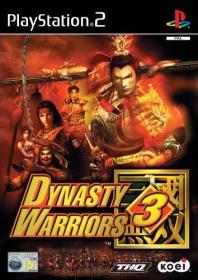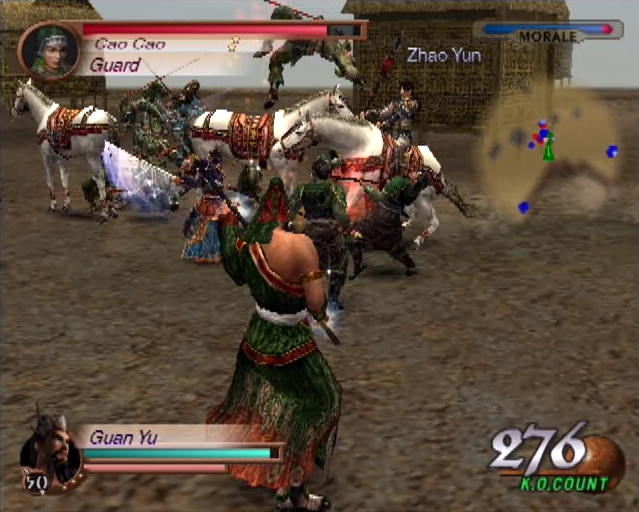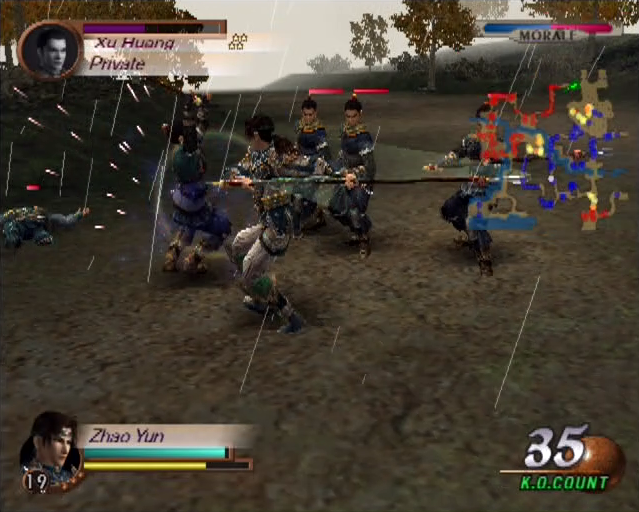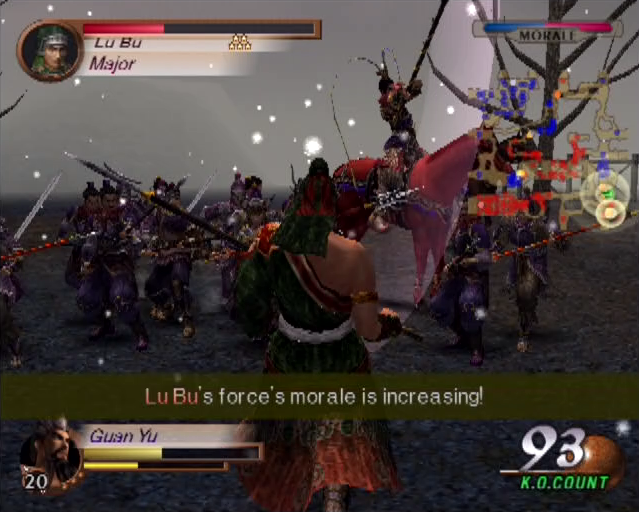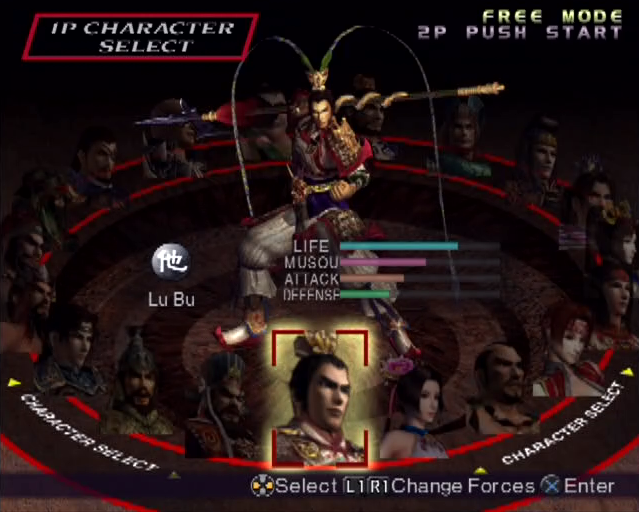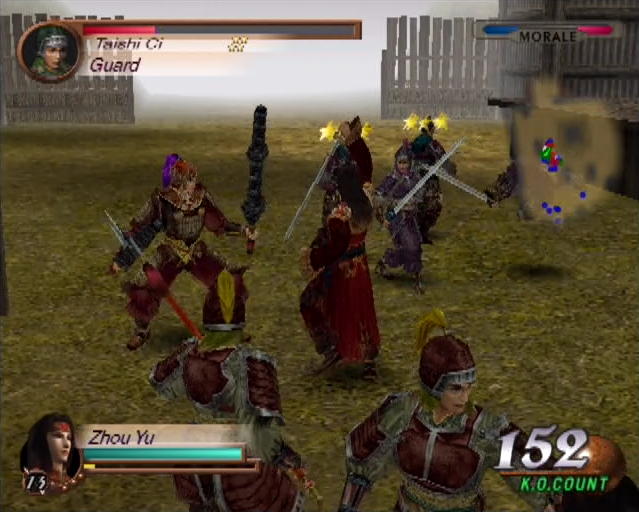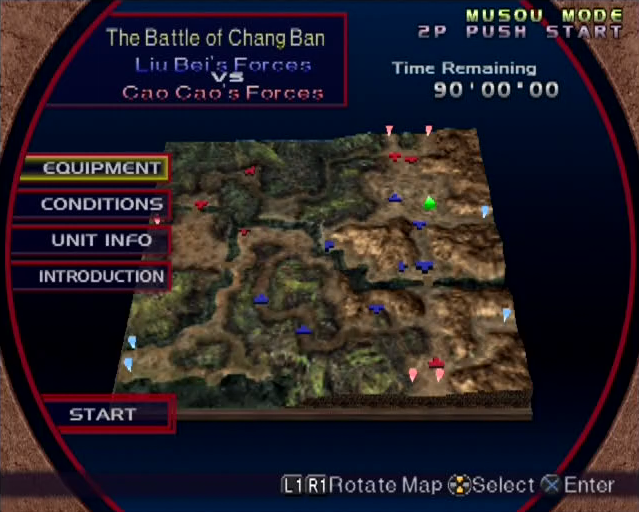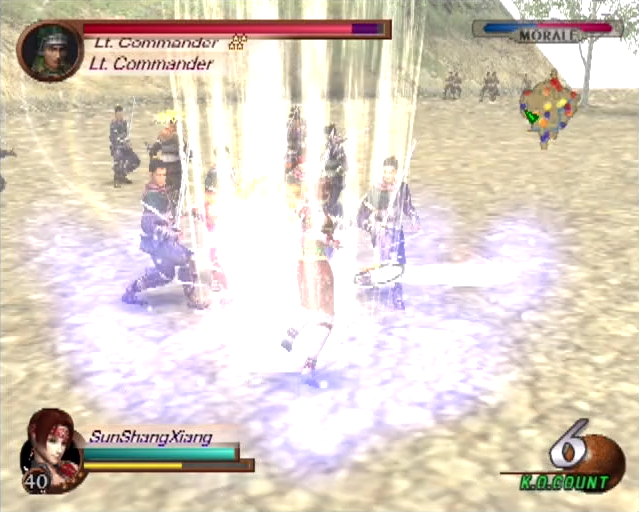DYNASTY WARRIORS 3 (PS3)
Nothing makes the games of yesteryear age more gracefully than nostalgia. It’s entirely normal to apply rose-tinted spectacles to games we idolised as children and as a consequence, this often results in them feeling a little underwhelming, years down the line. A strange inverse is also possible, where distinguished games don’t receive their dues because they carry the burden of association with what would follow. Nowadays, this is most commonly known as franchise fatigue. Would EA’s masterful trio of FIFA International Soccer, John Madden Football and EA Hockey have been celebrated more widely and more warmly, had their brands not become synonymous with annual updates and cash-grab philosophy? It's very likely. With this in mind, just short of its 20th birthday, it’s time we gave Dynasty Warriors 3 some recognition because it’s a fantastic game.
The two decades following DW3’s release have seen somewhere in the region of thirty-five distinct Dynasty Warriors video games. That number doesn’t factor in any of the myriad related titles such as Romance of the Three Kingdoms and Samurai Warriors, nor crossovers that include Hyrule Warriors and Dragon Quest Heroes. Certainly, during the sixth generation, it was soon apparent that whenever a Dynasty Warriors title rolled around, you were met with more or less the same product, with a recycling of story, battles and gameplay dynamics. Hefty baggage then, but this review doesn’t worry about that.
Dynasty Warriors 3 packs in a mammoth amount of action into each stage, with hundreds of KOs as standard
The term “system seller” isn’t used anywhere near as flippantly now as it was at the turn of the millennium. In truth, nobody was applying it to Dynasty Warriors 3 then, either. But in a way, with many players making the generational jump from the PlayStation to the PlayStation 2, it delivered an action game on a scale we could scarcely have dreamed of only a few years previous. Loosely framed around the events depicted in Chinese literary epic The Romance of the Three Kingdoms, DW3 presents a highly-stylised retelling from the perspectives of leaders, strategists, distinguished soldiers and officers from the Wu, Shu and Wei dynasties.
What you get is an extremely enjoyable, grandiose hack ‘n’ slash title. Enormous maps are populated with hundreds of soldiers, with the key to winning battles being to target key officers, thwart surprise attacks and avoid falling foul of the enemy’s sneaky tactics. Whilst the environments aren’t the most detailed you’ll find in a PS2 action game, what is impressive is just how good the frame-rate remains. With dozens of allies and enemies fighting on-screen together, it has to count amongst the busiest combat arenas ever seen in a real-time action game to this point.
DW3 is an unashamed case of style over substance, but for once, this isn’t a bad thing. It’s a bit of a button-masher but also rewards timing, blocking and building combos. Combat is satisfying and the controls just about spot-on. By successfully landing hits, the player builds their Musou gauge, allowing for some spectacular special attacks that are perfect for taking down swarms of opponents. The settings are impressively elaborate and there’s a host of superb levels for the player to enjoy. The Battle of Chibi (later the subject of the film Red Cliff) is ferocious, taking place across a fleet of adjoining ships. Executing/foiling a fire attack is instrumental to the player’s success in this battle. The Siege of He Fei Castle is another fearsome challenge that sees the player attempt to break through a formidable defensive structure with corridors of lethal crossbowmen. The Battle at Wu Zhang Plains makes for a fittingly epic finale, with hordes of tough foes and reinforcements to cope with. These battles feel special once you’ve played them through again as different officers (and indeed from different sides). Each unit plays a different, but important, role in how things play out. The balance of the forces involved is adjusted depending on the side the player is on, guaranteeing a strong challenge.
What you get is an extremely enjoyable, grandiose hack ‘n’ slash title. Enormous maps are populated with hundreds of soldiers, with the key to winning battles being to target key officers, thwart surprise attacks and avoid falling foul of the enemy’s sneaky tactics. Whilst the environments aren’t the most detailed you’ll find in a PS2 action game, what is impressive is just how good the frame-rate remains. With dozens of allies and enemies fighting on-screen together, it has to count amongst the busiest combat arenas ever seen in a real-time action game to this point.
DW3 is an unashamed case of style over substance, but for once, this isn’t a bad thing. It’s a bit of a button-masher but also rewards timing, blocking and building combos. Combat is satisfying and the controls just about spot-on. By successfully landing hits, the player builds their Musou gauge, allowing for some spectacular special attacks that are perfect for taking down swarms of opponents. The settings are impressively elaborate and there’s a host of superb levels for the player to enjoy. The Battle of Chibi (later the subject of the film Red Cliff) is ferocious, taking place across a fleet of adjoining ships. Executing/foiling a fire attack is instrumental to the player’s success in this battle. The Siege of He Fei Castle is another fearsome challenge that sees the player attempt to break through a formidable defensive structure with corridors of lethal crossbowmen. The Battle at Wu Zhang Plains makes for a fittingly epic finale, with hordes of tough foes and reinforcements to cope with. These battles feel special once you’ve played them through again as different officers (and indeed from different sides). Each unit plays a different, but important, role in how things play out. The balance of the forces involved is adjusted depending on the side the player is on, guaranteeing a strong challenge.
FOCAL POINT: ONE-MAN ARMY
The Battle of Hulau Gate provides yet another memorable conflict, as allied forces aim to unseat the tyrannical Dong Zhou from his heavily fortified position amidst the snow-capped hills. As well as hordes of smartly placed archers waiting to spring surprise attacks, he has one especially dangerous ally. Lu Bu, the game’s most devastatingly powerful officer, attacks with freakish strength and speed. Simply put, it’s better to steer well-clear the first time you tackle the mission. Should you manage to beat him, a supply unit will appear and having dispatched them, there's an item to collect that allows you to ride Lu Bu’s lightning-fast steed, Red Hare, into battle. Oh, and the warrior himself? Defeat 1,000 enemies on a single level and you’ll have more than earned the right to play as him.
Whilst the bigger missions are undoubtedly the best, several smaller ones present their own interesting challenges. The Battle of Fan Castle is a nerve-wracking, claustrophobic encounter that sees the player having to wade through a tightly packed core of enemies to avoid being caught in a flood. Elsewhere, Guan Yu’s Escape sees the mighty warrior fighting (more or less single-handedly) through a sequence of gates, each defended by an enemy officer.
There’s a dash of role-playing elements. Characters receive experience points based on enemy and officer takedowns as well as speed of completion and this translates into upgrades for your small troupe of bodyguards. There’s also a range of attribute upgrades, as well as items and weapons that can be equipped pre-mission. The only grumble associated with this is DW3’s frequent and frustrating habit of handing the player duplicates of their basic weapons, over and over. Getting past the mid-part of a Story campaign is a real slog if you haven’t got your hands on some improved weaponry.
Dynasty Warriors 3 looks good. Granted, a fog/rain effect is used to mask an unimpressive draw distance and some occasionally sparse-looking level layouts, but excellent, fluent combat animations and decent-looking soldiers grant the game the spectacle it’s aiming for. The Nanman Campaign introduces jungle settings to liven things up, whilst some of the more elaborate castle sieges also capture the imagination. The story is told through a host of FMVs that are, despite some whiffy voice acting, excellent. At this stage in the series, the rock-driven soundtracks were really good, adding lots of drama, even to the menus. There’s an impressively sizeable roster comprising of 41 characters, 13 of whom are new since Dynasty Warriors 2. Not only do the combatants look great and move with fluidity, there’s lots of variety, too. Combatants wield an impressively extensive array of spears, lances, fans and staffs and each has their own unique Musou attacks and extended combos.
There’s a dash of role-playing elements. Characters receive experience points based on enemy and officer takedowns as well as speed of completion and this translates into upgrades for your small troupe of bodyguards. There’s also a range of attribute upgrades, as well as items and weapons that can be equipped pre-mission. The only grumble associated with this is DW3’s frequent and frustrating habit of handing the player duplicates of their basic weapons, over and over. Getting past the mid-part of a Story campaign is a real slog if you haven’t got your hands on some improved weaponry.
Dynasty Warriors 3 looks good. Granted, a fog/rain effect is used to mask an unimpressive draw distance and some occasionally sparse-looking level layouts, but excellent, fluent combat animations and decent-looking soldiers grant the game the spectacle it’s aiming for. The Nanman Campaign introduces jungle settings to liven things up, whilst some of the more elaborate castle sieges also capture the imagination. The story is told through a host of FMVs that are, despite some whiffy voice acting, excellent. At this stage in the series, the rock-driven soundtracks were really good, adding lots of drama, even to the menus. There’s an impressively sizeable roster comprising of 41 characters, 13 of whom are new since Dynasty Warriors 2. Not only do the combatants look great and move with fluidity, there’s lots of variety, too. Combatants wield an impressively extensive array of spears, lances, fans and staffs and each has their own unique Musou attacks and extended combos.
The lightest sprinkling of strategy adds a lot to the intriguing battle for power between Wu, Shu and Wei
As you end up playing the same missions over and over again however, repetition does eventually start to set in and the satisfaction upon completing them eventually starts to diminish. Still, there’s an absolutely incredible amount of content here for a hack ‘n’ slash. Finishing every campaign will likely take 40 hours, whilst unearthing all the items and each of the character’s special weapons will likely take months. There’s tonnes to see and a superb, cooperative two-player split-screen proves the icing on the cake.
There’s the odd hiccup along the way. Generally, you have to remain in the crossbow’s first-person perspective for your arrow to register a hit. This can be especially irritating when a single hit from the A.I. can unceremoniously dump you out of this view and save them from damage. Also, given that some enemy generals and commanders are really tough to beat, their ability to occasionally heal themselves on the spot is especially unwelcome. Elsewhere, the camera operates quite well, though it doesn’t automatically remain behind the player, essentially creating a blind spot whenever you pass by an enemy. Configuring the camera to the right analogue stick would have been nice, but it’s a small gripe.
What Dynasty Warriors 3 lacks in complexity it makes up for in good old-fashioned fun. A fascinating story is brought to life through a cast of exciting and engaging fighters, whilst the game’s frequently huge battles hide a myriad of satisfying secrets and strong replayability. If you’re new to the series, don’t be put off what by what followed: this is really enjoyable. Well worth revisiting, though your square button may never forgive you.
There’s the odd hiccup along the way. Generally, you have to remain in the crossbow’s first-person perspective for your arrow to register a hit. This can be especially irritating when a single hit from the A.I. can unceremoniously dump you out of this view and save them from damage. Also, given that some enemy generals and commanders are really tough to beat, their ability to occasionally heal themselves on the spot is especially unwelcome. Elsewhere, the camera operates quite well, though it doesn’t automatically remain behind the player, essentially creating a blind spot whenever you pass by an enemy. Configuring the camera to the right analogue stick would have been nice, but it’s a small gripe.
What Dynasty Warriors 3 lacks in complexity it makes up for in good old-fashioned fun. A fascinating story is brought to life through a cast of exciting and engaging fighters, whilst the game’s frequently huge battles hide a myriad of satisfying secrets and strong replayability. If you’re new to the series, don’t be put off what by what followed: this is really enjoyable. Well worth revisiting, though your square button may never forgive you.
|
VERDICT
"What Dynasty Warriors 3 lacks in complexity it makes up for in good old-fashioned fun. A fascinating story is brought to life through a cast of exciting and engaging fighters, whilst the game’s frequently huge battles hide a myriad of satisfying secrets and strong replayability." OVERALL: 8/10 |
